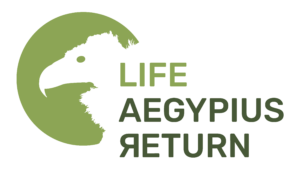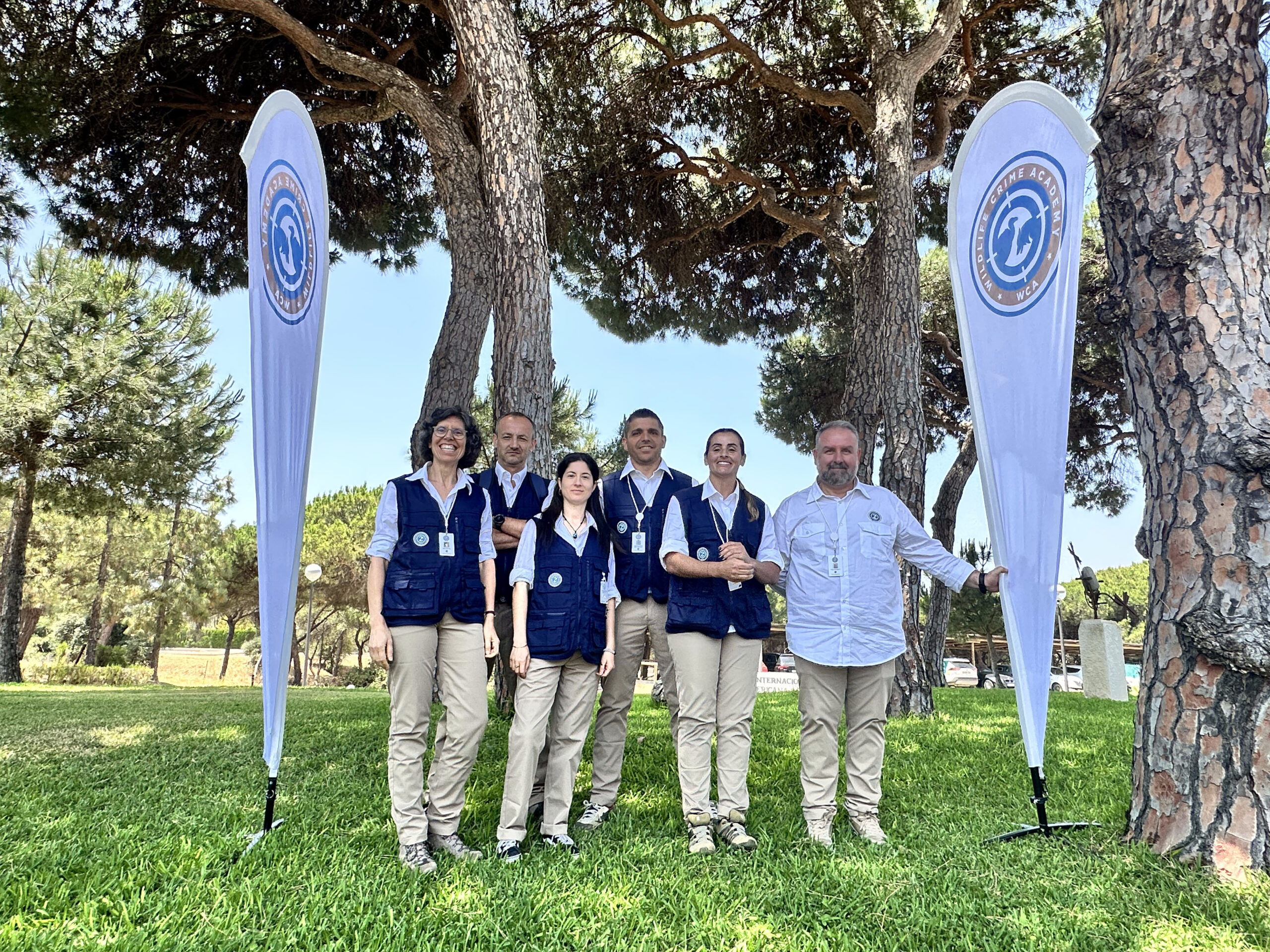The Cinereous Vulture population in Portugal has now safer nests and new nesting platforms available. The Cinereous Vulture (Aegypius monachus), Europe’s largest bird of prey, is impressive not only for its size but also for its unique reproductive characteristics. Adults reach sexual maturity at five or six years old and lay only one egg per breeding season. As philopatric birds, Cinereous Vultures exhibit remarkable fidelity to their birth territory, often returning as breeding adults to the region where they fledged. Ensuring the quality of their habitat and providing secure nesting sites is crucial to accommodate new birds and breeding pairs.

Cinereous Vulture: boosting breeding conditions in Portugal
The species builds its nests atop trees, creating a robust platform composed of wood pieces, branches, and vegetation, sometimes exceeding two meters in diameter. The breeding season spans about nine months, from initial nesting behaviours in January to the chicks’ independence in September or October. This leaves a narrow window for conservationists to approach nests without causing disturbance. Therefore, teams conduct nest inspections in the fall, evaluating their condition and addressing any risks of collapse or access impediments for the birds. In cases of degradation, reinforcement and maintenance actions are taken.
Safer nests and new nesting platforms
Given the relative rarity of this species in Portugal, another recurring conservation measure involves installing artificial nest platforms to increase nesting sites and enhance reproductive success in areas with favourable habitat conditions. In these instances, trees are reinforced with posts and metal baskets, mimicking the natural conditions necessary for nesting.
This autumn, the LIFE Aegypius Return project teams completed various interventions in the country’s four colonies. Cinereous Vultures now have 14 additional nesting sites, and safety measures were implemented for 20 existing nests.
Douro Internacional – nine new nesting platforms installed and four existing nests repaired
The Palombar team, with the collaboration of the Grupo de Intervención en Altura de la Comunidad de Madrid (GIAM, Dirección General de Emergencias – Cuerpo de Agentes Forestales), installed nine new platforms in the Special Protection Area (SPA) of Douro Internacional and Vale do Águeda, on cork oaks, holm oaks, and junipers, reinforcing actions initiated in 2019 under the LIFE Rupis project, as an emergency response and mitigation of the impact of the 2017 fire in Douro Internacional.
The teams also conducted maintenance on two natural and two artificial platforms, involving pruning, organising and reinforcing wood pieces, gorse branches, metal mesh, and filling with sheep wool. Other works in Douro Internacional included installing two anchoring systems, facilitating future nest access on cliffs, and placing a life-size replica of a Cinereous Vulture as a decoy to attract new breeding individuals.
“A specialised team experienced in working at heights was necessary because, in our region, Cinereous Vultures often build nests on top of trees near cliffs.”
José Pereira, Palombar

Serra da Malcata Nature Reserve: where the breeding season seems to have started earlier this year
Based on assessments by ICNF (the Portuguese Nature Conservation authority) and the NGOs Rewilding Portugal, Quercus and ATNatureza, two maintenance interventions were planned for natural nests, coordinated by the project partner ATNatureza, but only one was executed. One nest, viewed from below during the inspection woks, appeared somewhat fragile. However, upon climbing, Samuel Infante from Quercus, the responsible technician, found the nest secure, possibly already reinforced by the birds, as it showed signs of recent use, with green branches and fresh pellets. The nesting season started earlier, so it was decided not to intervene in this nest and leave the area as quickly as possible.


Tejo Internacional – Maintenance of five existing nests
The SPEA team coordinated the maintenance work on existing nests and artificial platforms in the SPAs Tejo Internacional, Erges, and Ponsul, also executed by Samuel Infante. In four nesting platforms, wood pieces and sticks were added to the top of the basket, and surrounding branches were pruned to provide space for the birds.
Interventions on a natural nest occupied in 2023 and at risk of lateral collapse are still ongoing. The tree’s height was measured to prepare a wooden support to prevent the nest from collapsing. Interestingly, two other old nests were found on the ground in the same location. A second visit will be made to install the support for the nest.

Herdade da Contenda – 10 safer nests and five new platforms
At Herdade da Contenda, located in the SPA of Moura/Mourão/Barrancos, the Liga para a Protecção da Natureza (LPN) and Herdade da Contenda, E.M. conducted maintenance and repairs on Cinereous Vulture nests. They also installed five new artificial nesting platforms with the support of the specialised technicians Carlos Pacheco and Timóteo Mendes.
Maintenance included structural reinforcement of two nests, pruning, adding additional plant material to five nests, and the complete reconstruction of three nests. One nest had fallen after two storms last October and had to be fully rebuilt. Another intervention was on a nest that had collapsed last summer, even causing a chick’s unfortunate fall and death.
Nest falling is a common problem; in 2010, when the species finally recolonised Portugal, both nests collapsed, and the chicks fell on the ground. If it weren’t for the zeal and determination of the team back then, both chicks would have probably died.
Five new artificial platforms were also installed in stone pine trees. One of these replaced a previous nest whose supporting tree had been toppled by the October storms.

78-81 breeding pairs were recorded in Portugal last season… will we have new pairs this season?
With the maintenance of existing nests and the construction of new artificial platforms for Cinereous Vultures completed, the monitoring of the 2024 breeding season is already underway. All teams are in the field, following the species monitoring protocol defined within the LIFE Aegypius Return project.
In 2022, there were around 40 nesting pairs estimated in Portugal, and in 2023, the number doubled to 78-81 due to careful prospecting for new nests, monitoring, and data coordination from various organisations. Despite the number of pairs, breeding success still needs to be higher to ensure the species’ long-term survival; therefore, enhancing breeding conditions is fundamental.

It is important to note that all the nest interventions are carried out by specialised technicians trained for this purpose in high-security conditions, ensuring no disturbance to the birds and with the proper authorisation from the Institute for Nature Conservation and Forests.
The LIFE Aegypius Project
The LIFE Aegypius Return project aims to consolidate and accelerate the return of the Cinereous Vulture in Portugal and western Spain by improving habitat and food availability and minimising the main threats. The project team will implement specific conservation actions in ten Natura 2000 areas along almost the entire border between Portugal and Spain to double the Cinereous Vulture population in Portugal to 80 pairs in 5 colonies and thus lower the national status of the species from Critically Endangered to Endangered by 2027.

The LIFE Aegypius Return is a 3.7 million project, co-financed by the European Union’s LIFE Programme, whose success relies on the involvement of all relevant stakeholders and the extensive collaboration of the leading project partner, the Vulture Conservation Foundation (VCF), with all local partners: Palombar – Conservação da Natureza e do Património Rural, Herdade da Contenda, Sociedade Portuguesa para o Estudo das Aves (SPEA), Liga para a Protecção da Natureza (LPN), Associação Transumância e Natureza (ATN), Fundación Naturaleza y Hombre (FNHY), Guarda Nacional Republicana (GNR) and Associação Nacional de Proprietários Rurais Gestão Cinegética e Biodiversidade (APNC).




